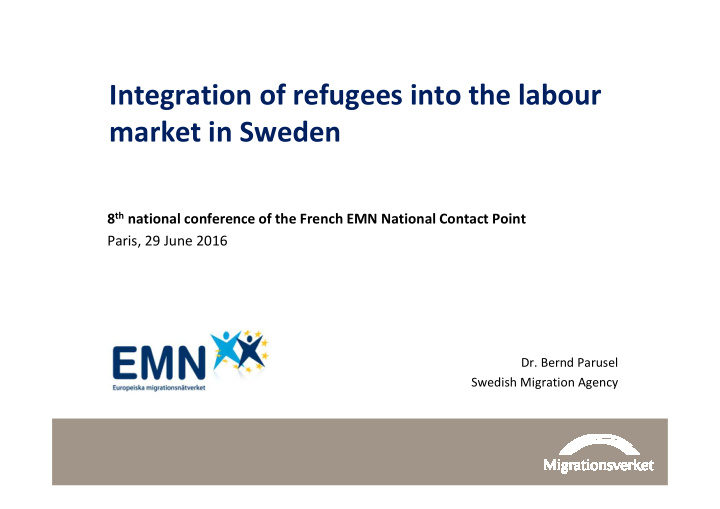



Integration of refugees into the labour market in Sweden 8 th national conference of the French EMN National Contact Point Paris, 29 June 2016 Dr. Bernd Parusel Swedish Migration Agency
Basic principles for refugees´ access to the labour market and welfare in Sweden • There are work-based and residence-based welfare rights and entitlements • Anybody who legally works in Sweden has a right to work-based benefits (e.g. unemployment benefit, sickness benefit, pensions) • Anyone who is legally residing in Sweden is entitled to residence-based benefits (e.g. social welfare benefits, child allowance, housing allowance) • Basic rule for legal residence: Anyone who legally stays in Sweden, or can be expected to stay, for one year or longer , is registered in the population registry and thus entitled to residence-based rights/benefits • Once an asylum seeker is granted refugee status, subsidiary protection or a humanitarian status, they are registered in the population registry • Asylum seekers are normally allowed to work during the asylum procedure (no priority examination or waiting time)
Special integration measures for recognised beneficiaries of protection (and family members) • Settlement in one of the 290 Swedish municipalities, according to a new distribution/allocation mechanism (since March 2016) – organised by the Public Employment Service Arbetsförmedlingen • Beneficiaries of protection may also find accommodation by themselves • Individual “integration plan” (normal duration: two years), including: – Language course “Swedish for Immigrants”: Normally 15-20 hours per week, day-time (there are also evening classes and special courses for persons with specific skills) – Shorter orientation courses – Internships , apprenticeships or on-the-job training
Other components of the integration plan • Translation of foreign diplomas • Guidance regarding the validation of formal degrees / education • New: short, complementary education programmes for people with incomplete qualifications • Financial allowances (daily) : – 231:- to 308:- SEK per day (Monday-Friday), dependent on the degree of participation in the activities foreseen by the integration plan – Extra allowances in certain cases for children and housing – Reduced allowances when beneficiary starts working or does not fully participate, e.g. 50 % work or absence → allowances reduced by 50 %
Recent challenges • Almost 163.000 new asylum 180 000 seekers in 2015, more than ever 160 000 140 000 • Lack of affordable housing → 120 000 Settlement process is delayed 100 000 80 000 • Over-burdening of responsible 60 000 authorities and agencies (state 40 000 20 000 and municipalities) → too little 0 time for individual help • Lack of simple jobs → Takes years until new arrivals find jobs • Longer waiting times in the asylum system and for family reunification
New measures for improved labour market participation (1) • Basic idea : Beneficiaries of protection have to get closer to the more dynamic regions within Sweden, where there are jobs • But: Also in remoter regions, there is a certain need for labour (e.g. in agriculture and forestry) • Increased focus on internships, on-the-job training, earlier language tuition • Make meaningful use of waiting times during the asylum procedure • „100-Club“ – Special package solutions for bigger companies that commit to employing at least 100 new arrivals, including special placement services and wage subsidies
New measures for improved labour market participation (2) • „Fast-tracks“ into the labour market for new arrivals with qualifications for shortage occupations , e.g. – Cooks (chefs) – Doctors, nurses, pharmacists and dentists – Butchers – School and pre-school teachers • Government-subsidised jobs in the private economy („Step-in jobs“) • More funding for civil society initiatives
Thank you! Dr. Bernd Parusel bernd.parusel@migrationsverket.se
Recommend
More recommend